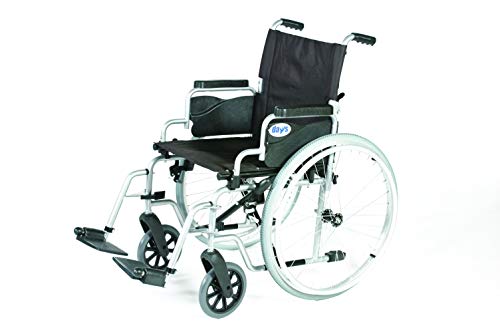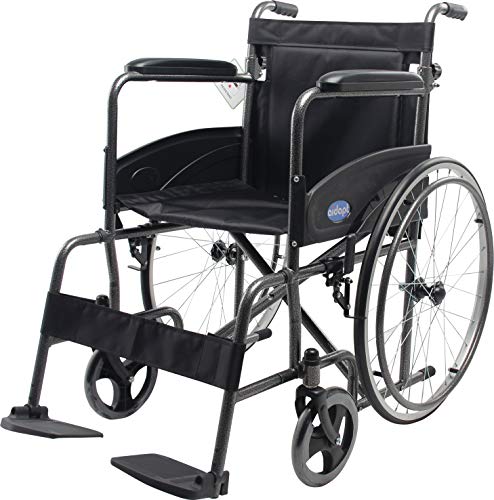See What Self Control Wheelchair Tricks The Celebs Are Using
페이지 정보

본문
 Types of Self Control Wheelchairs
Types of Self Control WheelchairsMany people with disabilities utilize self control wheelchairs to get around. These chairs are ideal for everyday mobility and can easily climb up hills and other obstacles. They also have huge rear flat, shock-absorbing nylon tires.
 The velocity of translation for the wheelchair was measured using a local field-potential approach. Each feature vector was fed to an Gaussian encoder that outputs a discrete probabilistic distribution. The accumulated evidence was then used to drive visual feedback, as well as a command delivered when the threshold had been attained.
The velocity of translation for the wheelchair was measured using a local field-potential approach. Each feature vector was fed to an Gaussian encoder that outputs a discrete probabilistic distribution. The accumulated evidence was then used to drive visual feedback, as well as a command delivered when the threshold had been attained.Wheelchairs with hand-rims
The kind of wheels a wheelchair has can affect its maneuverability and ability to traverse different terrains. Wheels with hand-rims reduce wrist strain and improve the comfort of the user. Wheel rims for wheelchairs can be found in steel, aluminum, plastic or other materials. They also come in a variety of sizes. They can be coated with vinyl or rubber to provide better grip. Some are designed ergonomically, with features such as shapes that fit the grip of the user and wide surfaces to allow for full-hand contact. This allows them to distribute pressure more evenly and reduce fingertip pressure.
A recent study revealed that flexible hand rims reduce impact forces as well as wrist and finger flexor activity when using a wheelchair. They also provide a larger gripping surface than standard tubular rims which allows the user to exert less force while maintaining excellent push-rim stability and control. They are available at most online retailers and DME providers.
The results of the study revealed that 90% of respondents who had used self propelled wheelchair the rims were happy with them. However, it is important to keep in mind that this was a postal survey of people who purchased the hand rims from Three Rivers Holdings and did not necessarily represent all terrain self propelled wheelchair wheelchair users with SCI. The survey did not measure the actual changes in pain or symptoms or symptoms, but rather whether individuals perceived an improvement.
The rims are available in four different models, including the light, medium, big and prime. The light is a small round rim, and the medium and big are oval-shaped. The rims on the prime are a little bigger in diameter and feature an ergonomically shaped gripping surface. all terrain self propelled wheelchair uk of these rims are able to be fitted on the front wheel of the wheelchair in a variety colors. They are available in natural light tan as well as flashy greens, blues, pinks, reds, and jet black. They also have quick-release capabilities and can be easily removed to clean or maintain. Additionally, the rims are coated with a rubber or vinyl coating that helps protect hands from sliding across the rims and causing discomfort.
Wheelchairs with tongue drive
Researchers at Georgia Tech developed a system that allows people in a wheelchair to control other devices and maneuver it by moving their tongues. It is made up of a small tongue stud that has a magnetic strip that transmits signals from the headset to the mobile phone. The phone converts the signals to commands that can be used to control the device, such as a wheelchair. The prototype was tested by disabled people and spinal cord injury patients in clinical trials.
To assess the performance of this device it was tested by a group of able-bodied individuals used it to perform tasks that measured the speed of input and the accuracy. They completed tasks based on Fitts law, which includes keyboard and mouse use, and maze navigation tasks using both the TDS and a standard joystick. The prototype had an emergency override button in red, and a friend was with the participants to press it when needed. The TDS performed just as a standard joystick.
Another test compared the TDS against the sip-and puff system, which allows people with tetraplegia to control their electric wheelchairs by sucking or blowing air into a straw. The TDS was able to complete tasks three times faster and with better precision than the sip-and-puff. The TDS is able to operate wheelchairs more precisely than a person with Tetraplegia who controls their chair with the joystick.
The TDS could track the position of the tongue to a precision of under one millimeter. It also included cameras that recorded the eye movements of a person to identify and interpret their movements. It also came with software safety features that checked for valid inputs from users 20 times per second. Interface modules would automatically stop the wheelchair if they did not receive an acceptable direction control signal from the user within 100 milliseconds.
The next step for the team is to test the TDS on individuals with severe disabilities. They're collaborating with the Shepherd Center located in Atlanta, a hospital that provides catastrophic care and the Christopher and Dana Reeve Foundation to conduct these trials. They plan to improve their system's ability to handle ambient lighting conditions, to include additional camera systems, and to enable the repositioning of seats.
Joysticks on wheelchairs
A power wheelchair with a joystick allows users to control their mobility device without having to rely on their arms. It can be mounted either in the middle of the drive unit, or on either side. It also comes with a screen that displays information to the user. Some screens have a big screen and are backlit for better visibility. Others are smaller and could include symbols or images to assist the user. The joystick can be adjusted to fit different hand sizes and grips as well as the distance of the buttons from the center.
As power wheelchair technology evolved, clinicians were able to develop alternative driver controls that allowed clients to maximize their potential. These advances enable them to do this in a manner that is comfortable for end users.
A typical joystick, as an example, is a proportional device that utilizes the amount deflection of its gimble to produce an output that increases as you exert force. This is similar to how video game controllers or accelerator pedals in cars work. However this system requires motor function, proprioception, and finger strength to be used effectively.
Another type of control is the tongue drive system, which relies on the position of the tongue to determine where to steer. A tongue stud with magnetic properties transmits this information to the headset which can perform up to six commands. It can be used by those with tetraplegia or quadriplegia.
Some alternative controls are more simple to use than the standard joystick. This is particularly beneficial for people with limited strength or finger movements. Some of them can be operated with just one finger, making them ideal for those who can't use their hands at all or have minimal movement in them.
Additionally, certain control systems come with multiple profiles that can be customized to meet the specific needs of each customer. This is crucial for new users who may need to adjust the settings periodically when they feel tired or have a flare-up of an illness. This is helpful for experienced users who wish to change the settings set for a particular area or activity.
Wheelchairs with steering wheels
self control wheelchair-propelled wheelchairs are designed to accommodate individuals who need to move themselves on flat surfaces as well as up small hills. They come with large rear wheels for the user to grip as they propel themselves. They also have hand rims, which allow the individual to use their upper body strength and mobility to control the wheelchair in either a either direction of forward or backward. self propelled wheelchairs for sale control wheelchair (https://longshots.wiki/wiki/7_Simple_Tricks_To_Totally_Doing_The_Self_Propelled_Lightweight_Folding_Wheelchair)-propelled wheelchairs come with a range of accessories, such as seatbelts that can be dropped down, dropdown armrests and swing-away leg rests. Some models can be converted to Attendant Controlled Wheelchairs, which permit family members and caregivers to drive and control wheelchairs for those who need more assistance.
To determine kinematic parameters, participants' wheelchairs were equipped with three sensors that monitored movement over the course of an entire week. The gyroscopic sensors that were mounted on the wheels and attached to the frame were used to measure wheeled distances and directions. To discern between straight forward movements and turns, periods of time when the velocity differences between the left and the right wheels were less than 0.05m/s was deemed straight. The remaining segments were examined for turns and the reconstructed paths of the wheel were used to calculate turning angles and radius.
The study involved 14 participants. They were tested for navigation accuracy and command latency. Using an ecological experimental field, they were asked to steer the wheelchair around four different ways. During the navigation tests, sensors tracked the path of the wheelchair across the entire distance. Each trial was repeated at minimum twice. After each trial, participants were asked to pick a direction for the wheelchair to move within.
The results revealed that the majority of participants were competent in completing the navigation tasks, although they did not always follow the right directions. On average 47% of turns were correctly completed. The remaining 23% either stopped immediately following the turn, or redirected into a subsequent moving turning, or replaced by another straight movement. These results are similar to those from earlier research.
- 이전글5 Killer Quora Answers On Affordable Cots 24.11.25
- 다음글The Three Greatest Moments In Citroen C3 Key Replacement History 24.11.25
댓글목록
등록된 댓글이 없습니다.

